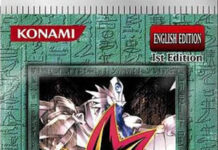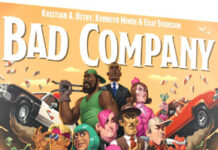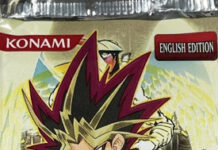If you consult the Magic: the Gathering wiki that used to be affiliated with MTG Salvation, and look up the entry about the original batch of Mystery Booster test cards, you’ll see that they dug up a quote from Mark Rosewater about how he (and, he implies, others inside Wizards) didn’t think anyone would really play with them, and complaining that people ask him when various test cards will get a more conventional version. Yet his comments are directly contradicted by some of the promotional materials and rules notes for the playtest cards, which commented on how they might spice up a lot of cube and casual constructed formats.
I go with the latter position and will defend it strongly, now and forever. Casual Magic is big enough for most anything you can think of. People play formats with unrestricted Power Nine which are way more broken than anything from a Mystery Booster bonus sheet – and some people play with designs they made themselves, where the difference between one set of supposedly not-real cards and another is merely who printed them. You can no longer say that Magic cards “don’t look like” any particular thing now that Secret Lair exists. Most of the test cards’ mechanics are not so much further out-there than a conventional Un-set, or Future Sight.
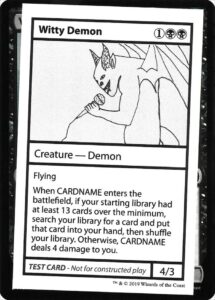
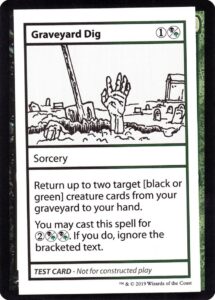
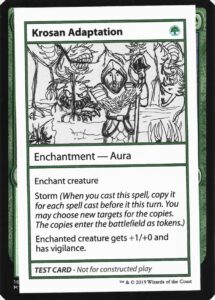
That actually brings up another way that Wizards of the Coast contradicted Rosewater’s comments on playtest cards: many of their mechanics have since appeared in mainline sets, much like with Unglued and Future Sight. Witty Demon foreshadowed the companion mechanic (even, amusingly, Yorion’s deckbuilding clause). Graveyard Dig is clearly a forerunner of cleave, and the mind-blowing Krosan Adaptation led to permanents with storm in Modern Horizons 2. Enchantmentize is literally just a regular card now, though they changed its name to the more evocative One With the Stars.
I tend not to see a lot of playtest cards in the popular cubes on CubeCobra, or in casual decks people post on Commander databases or forum communities. Yet people clearly picked up on all the encouragement, because there is going to be another batch of playtest cards in Mystery Booster 2. A lot of people must actually be playing with them, or at the very least appreciating them. And Wizards of the Coast seems to be encouraging it even more this time around, because the playtest cards not only have a more consistent line-drawing style with credited artists, but also even more interesting Un-set/Future Sight-style riffs on design, with a few cards and mechanics that I’d bet money will be in mainline sets eventually. I think this batch is just as delightful as the first, and I’m very excited to pre-review more of them now.
At the time of writing, I had not yet played with any of the cards in question and didn’t even own any, so everything I say is based on reading them and using my experience to extrapolate. Like the first time around, this series will be sorted by color, but the main criterion for discussing a card will be whether it catches my eye or appeals to me; these are undoubtedly not the only things you could say about the set, and certainly not all the cards you might like to play with. You can make that decision for yourself.
Ready? Let’s get nuts.
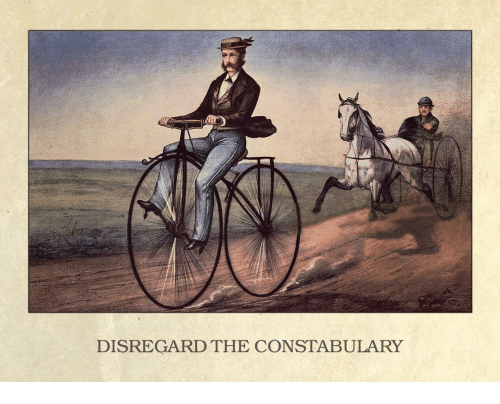
All of the colors are interesting to consider from a design and future card prospects point of view, but white has had arguably the most ups and downs of any of them. I remember the Onslaught era well, as it was the first time I really knew the rules rigorously. I remember how many damage prevention and toughness-boosting effects white got back then – it was way more than you think, and way more than we mean when we say “a lot” in the context of a modern set. Those cards are cruelly deceptive in the context of both draft and constructed: they seem superficially like they’re doing something, but they are actually doing nothing (in the Null Rod sense). Your opponent might not be able to break through and damage you, but they also don’t help you break through and damage your opponent. You don’t want game pieces that actively promote boredom, yet white got a disproportionate number of them in the years around Magic’s decadal anniversary. It was perhaps an understandable overreaction to unpopular strategies from Magic’s early years – Swords to Plowshares is legitimately too good for most formats, Armageddon is just miserable, and it’s easy to believe that people didn’t like having games stolen by Savannah Lions backed up with Winter Orb. But the pendulum swung too far and defined white as a do-nothing color for far too long. I do not miss that trope of 2000s design; and it’s not the only one that should stay in that decade.
There are still sets when white – and sometimes other colors – seems to fall into a rut of rearranging words like “attack”, “+1/+1”, “counter”, and “token”. But overall it’s designed much better now, and sets like Mystery Booster‘s playtest cards hint at untapped design potential. Having said that, I have to show some recognition for a card that is probably not part of Magic’s design future:
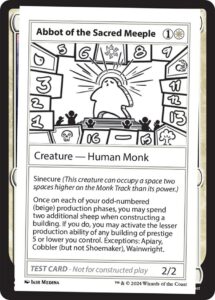
Abbot of the Sacred Meeple is most likely just a fun callout for people who are familiar with games like Carcassonne. Those games play differently enough from Magic that it seems unlikely that any of their mechanics will cross-over full-time, but I think this card still has value beyond that. It reminds us that Magic is at its most fun when people can choose their own experiences, that there is no one right way to play, and that nobody can tell you what to do with your physical printed cards once you own them. In other words, I absolutely encourage anyone reading this to make a variant or alternate format in which this card’s game text makes sense. Even Commander can’t bear the entire weight of casual Magic on its own.
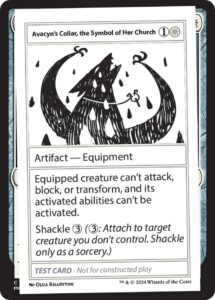
A few people who’ve seen this said they were surprised that the shackle ability didn’t already exist. Honestly, I kind of am too, though that design space seems to be largely occupied by auras right now. Regardless of what card type it involves, my main design issue with this type of removal is that it is ostensibly reversible yet often turns out to be permanent: a lot of decks in tournaments and casual settings don’t have maindeck removal for artifacts or enchantments. Cards like this are naturally weak against sacrificing and flickering effects, but those are also specific types of matchups that don’t come up the rest of the time. Still, this effect is very evocative, and I would not be surprised if we get a mainline variant of it at some point.
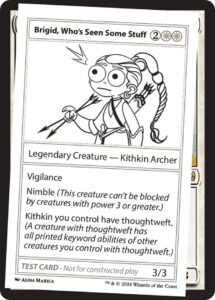
In a gameplay sense, I’m not sure what to make of Brigid’s abilities. Both of her new keywords make sense; almost too much sense, considering the kinds of weird stuff we’ve seen Wizards of the Coast experimenting with in recent sets. Nimble might read like an unnecessary new evasion ability, but I could actually imagine it playing a role in the right metagame. Apparently people have suggested that you wouldn’t use flying in an underwater-themed set, and something like nimble would likely work better there. More generally, it could make for some evocative designs based on acrobats, Lorwyn’s giant-baiters, or similar concepts. Wizards of the Coast was actually close to introducing it under a different name in Ikoria: Lair of Behemoths.
As for thoughtweft, I was always disappointed that the original Lorwyn set didn’t have much mechanical representation of the thoughtweft. It’s the thing that makes the plane’s kithkin unique, and while we accepted the various global untapping and instant-speed creatures as its representatives at the time, I think we’re allowed to expect more from the return next year. The main issue with thoughtweft as written is that some people will be confused as to just what’s a keyword and what isn’t. Landfall is actually an ability word, and scry is a keyword action; the difference is subtle.
In a non-gameplay sense, Brigid is holding up amazingly well considering the events of the first Lorwyn block. I can imagine few things more frightening than surviving the Great Aurora with your memories intact and thus having to live in Shadowmoor while remembering Lorwyn, then being the one who had to fight Ashling the Extinguisher.
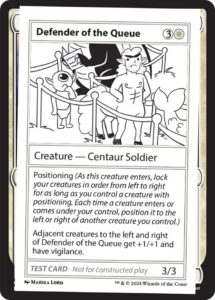
Funnily enough, effects like this already exist in some other TCGs. Yu-Gi-Oh, for example, only allows you to control five monsters at one time, and you have to specify their position on the table. Technically, the concept of positioning already exists in Magic – see Raging River, Problematic Volcano, Space Beleren – but when you start doing it a lot, you open the door to confusion. Especially when you are generating a lot of tokens, as so many cards seem to be doing nowadays. Still, something like this could make for an interesting combat trick or enhancement, and it solves some of the issues with mechanics like soulbond (assuming nobody’s trying to sneakily reposition their creatures!).
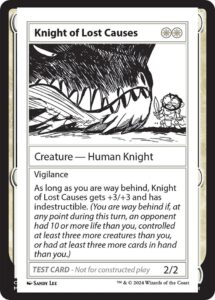
In the Card of the Day section, we’re fond of describing cards as “comeback cards”, and some people criticize cards for only being good when you’re behind. It was probably always likely that Mystery Booster test cards or an Un-set would reference the concept at some point. The thing I notice about this card’s definition of “way behind” is that all its metrics are intuitive measures of being behind, but do not always mean you are actually behind in the context of real Magic. That’s just one of the things that makes the game so complex and difficult. (Do not try to start something with me claiming that new players don’t need a lot more help than they’re getting. They do.) Still, like many Mystery Booster test cards, this does feel like it could be a black-bordered card after a little refinement.
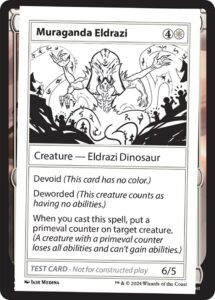
You might have seen me posting recently about my yearning to play with vanilla creatures. I actually went ahead and put both Regathan Firecat and Nessian Courser in my custom Jumpstart packs, but have not yet reached any conclusions about how they play there. Vanilla creatures can be cool, but Muraganda Eldrazi suggests at least one method by which you could do a “vanilla world” without doing only vanilla creatures – ironically with a degree of complexity. I honestly have no idea whether this card is a sign that Gavin Verhey is looking for a way to such a world, or just a Time Spiral-ish mashup. Yet it’s definitely worth noting that Mark Rosewater loved to insist there was no way to do a Muraganda “vanilla world”, but just reading this card sparks more than one idea about how to build the rest of the set.
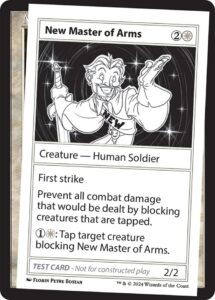
This many years down Magic’s timeline, this card probably counts as a very deep cut, as the internet likes to say. The Weatherlight card Master of Arms has almost the exact game text, but you’ll notice it’s missing that middle clause – in 1997, the rules stated outright that blocking creatures that were tapped dealt no damage. That rule was eventually changed, and the original Master of Arms briefly had errata that made it function as before. That was later removed, though, and it reverted to a card that does basically nothing.
The original Master of Arms was also notable for being the first on-card portrayal of Gerrard Capashen, but not named as such. I am not sure how that happened, considering that legendary creatures had been a concept for three years at that point. It did start a nearly two-decade phenomenon where the ostensible hero of the Weatherlight Saga appeared mostly on weak cards, which they seem to have reacted to in later years: look, for example, at how strong planeswalker cards depicting Jace, Chandra, and other popular characters tend to be.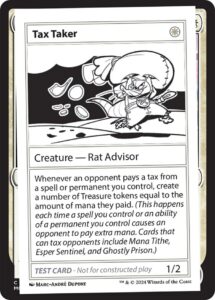
You may have heard that Commander’s rules committee is doing some sort of silver-border project right now. It seems to involve classifying silver-bordered cards based on how close they are to being “normal” Magic cards. It seems clear that people who reject silver-bordered cards out of hand have not actually looked at as many as they want you to believe: some of them got black-bordered versions at some point after they came out. A few had black-bordered versions before they came out. If what you want is to preserve a certain type of core Magic gameplay, such as not having to use physical dexterity or call someone on a telephone to resolve effects, the majority of Un-cards fit that already. I currently or have in the past used Un-cards like Target Minotaur, Amateur Auteur, As Luck Would Have It, Sword of Dungeons and Dragons, Everythingamajig, and Garbage Elemental in otherwise all-black-bordered decks, and it’s barely noticeable.
I mention this because Tax Taker is seriously close to being a “normal” Magic card. It would not surprise me if the floodgates are open now that mill is used as a standard term on cards – and tax is a similarly elegant concept, which is also already used by many players. It actually has more internal logic than mill, which has little connection to the game action other than the card Millstone. I have a feeling people might be playing with Tax Taker or a similar card in tournaments, comparatively soon as these things go.
Note that as defined, Tax Taker doesn’t trigger from ward abilities. It’s common to shortcut paying for ward as just paying extra mana (or whatever the cost is), but recall that it’s actually a triggered ability that tries to counter the offending spell.
Edited to add on October 3rd:
I am no longer certain that Tax Taker’s ability doesn’t apply to ward. Ward is an ability of the permanent that was targeted, so it might actually apply if the ward ability asks you to pay extra mana. This confusion is probably why Tax Taker is still technically a test card right now!
Next time, we’ll look at some of Myster Booster 2‘s blue test cards, where I’ll probably be making the “close to regular card” comparison slightly less often.

